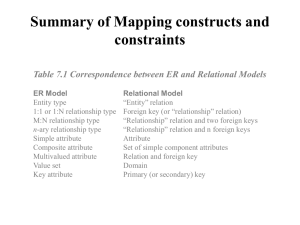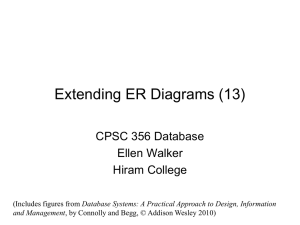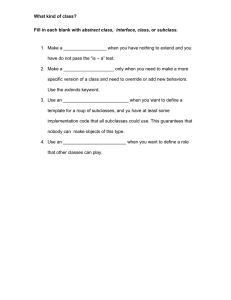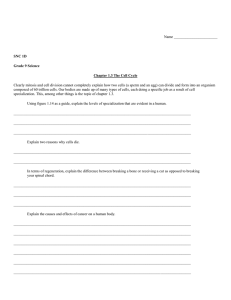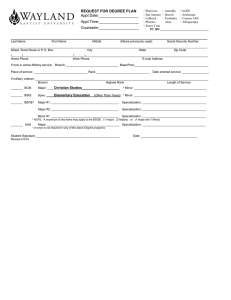327783 1 hw3-11 (1)
advertisement
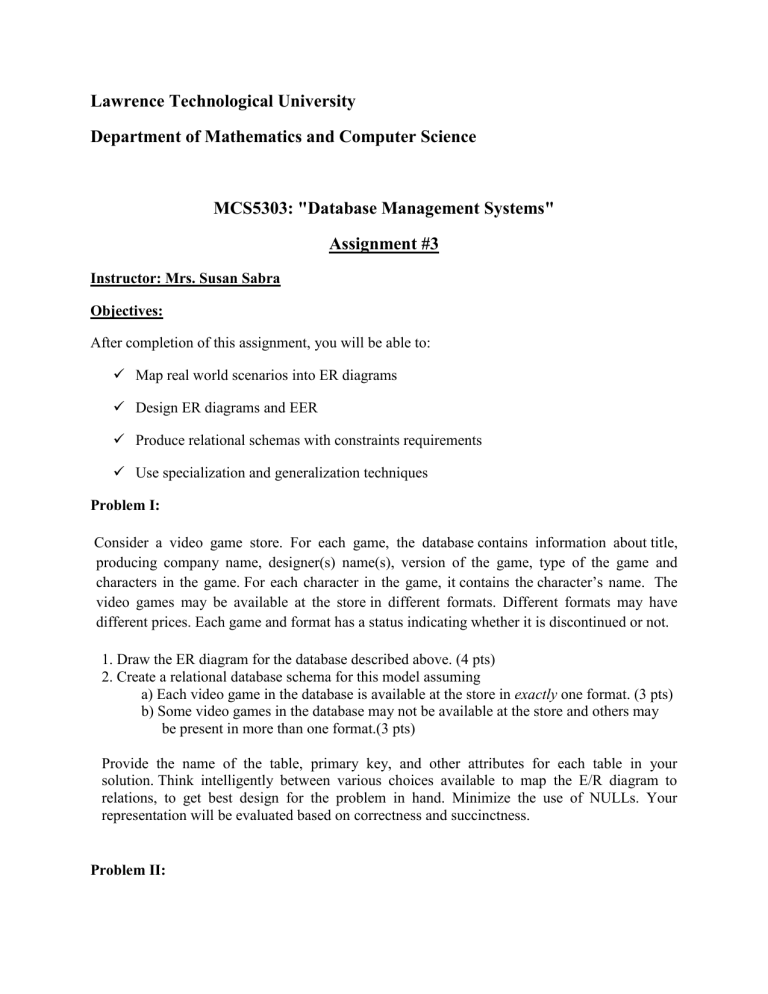
Lawrence Technological University
Department of Mathematics and Computer Science
MCS5303: "Database Management Systems"
Assignment #3
Instructor: Mrs. Susan Sabra
Objectives:
After completion of this assignment, you will be able to:
Map real world scenarios into ER diagrams
Design ER diagrams and EER
Produce relational schemas with constraints requirements
Use specialization and generalization techniques
Problem I:
Consider a video game store. For each game, the database contains information about title,
producing company name, designer(s) name(s), version of the game, type of the game and
characters in the game. For each character in the game, it contains the character’s name. The
video games may be available at the store in different formats. Different formats may have
different prices. Each game and format has a status indicating whether it is discontinued or not.
1. Draw the ER diagram for the database described above. (4 pts)
2. Create a relational database schema for this model assuming
a) Each video game in the database is available at the store in exactly one format. (3 pts)
b) Some video games in the database may not be available at the store and others may
be present in more than one format.(3 pts)
Provide the name of the table, primary key, and other attributes for each table in your
solution. Think intelligently between various choices available to map the E/R diagram to
relations, to get best design for the problem in hand. Minimize the use of NULLs. Your
representation will be evaluated based on correctness and succinctness.
Problem II:
You are to design a database for an insurance company. The data will include information about
customers (name, address, phone number), information about insured cars (make, model, year,
vehicle-ID#, license#, insurance rate), information about insured homes (address, insured value,
insurance rate), and information about claims made on insured cars and homes (date of claim,
date of settlement, amount of settlement). You may assume that all insured cars and homes are
owned by a single customer, but you should allow a customer to own several cars and homes.
Please state any additional assumptions you make about the real world in your design.
a) Specify an entity-relationship (E/R) diagram for your database. Don't forget to underline key
attributes for entity sets and include arrowheads indicating the multiplicity of relationships
(with rounded arrowheads for referential integrity). If there are weak entity sets or "isa"
relationships, make sure to notate them appropriately.
Problem III:
Consider the EER diagram for a car dealer in the figure below. Map the EER schema into a set of
relations. For the VEHICLE to CAR/ TRUCK/ SUV generalization, consider the four options
presented in Section 9.2.1 and show the relational schema design under each of those options.
Here the section for 9.2.1 to help you in problemIII:
9.2.1 Mapping of Specialization or Generalization
There are several options for mapping a number of subclasses that together
form a specialization (or alternatively, that are generalized into a superclass),
such as the {SECRETARY, TECHNICIAN, ENGINEER} subclasses of EMPLOYEE
in Figure 8.4. We can add a further step to our ER-to-relational mapping
algorithm from Section 9.1.1, which has seven steps, to handle the mapping
of specialization. Step 8, which follows, gives the most common options;
other mappings are also possible. We dis- cuss the conditions under which
each option should be used. We use Attrs(R) to denote the attributes of
relation R, and PK(R) to denote the primary key of R. First we describe the
mapping formally, then we illustrate it with examples.
Step 8: Options for Mapping Specialization or Generalization. Convert each
specialization with m subclasses {S1, S2, ..., Sm} and (generalized) superclass
C, where the attributes of C are {k, a1, ...an} and k is the (primary) key, into
relation schemas using one of the following options:
▪
Option 8A: Multiple relations—superclass and subclasses. Create a relation L for C with attributes Attrs(L) = {k, a1, ..., an} and PK(L) = k.
Create a relation Li for each subclass Si, 1 i m, with the attributes
Attrs(Li) = {k} {attributes of Si} and PK(Li) = k. This option works
for any specialization (total or partial, disjoint or overlapping).
▪
Option 8B: Multiple relations—subclass relations only. Create a relation
Li for each subclass Si, 1 i m, with the attributes Attrs(Li) =
{attributes of Si} {k, a1, ..., an} and PK(Li) = k. This option only
works for a specialization whose subclasses are total (every entity in
the superclass must belong to (at least) one of the subclasses).
Additionally, it is only recommended if the spe- cialization has the
disjointedness constraint (see Section 8.3.1).If the special- ization is
overlapping, the same entity may be duplicated in several relations.
▪
Option 8C: Single relation with one type attribute. Create a single
relation L with attributes Attrs(L) = {k, a1, ..., an} {attributes of S1}
... {attrib- utes of Sm} {t} and PK(L) = k. The attribute t is called
a type (or
9.2 Mapping EER Model Constructs to Relations 295
discriminating) attribute whose value indicates the subclass to which each
tuple belongs, if any. This option works only for a specialization whose subclasses are disjoint, and has the potential for generating many NULL values if
many specific attributes exist in the subclasses.
■
Option 8D: Single relation with multiple type attributes. Create a single
relation schema L with attributes Attrs(L) = {k, a1, ..., an} {attributes of
S1} ... {attributes of Sm} {t1, t2, ..., tm} and PK(L) = k. Each ti, 1 i
m, is a Boolean type attribute indicating whether a tuple belongs to
subclass Si. This option is used for a specialization whose subclasses are
overlapping (but will also work for a disjoint specialization).
